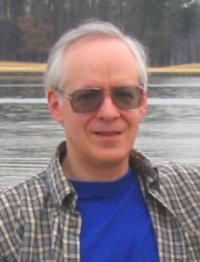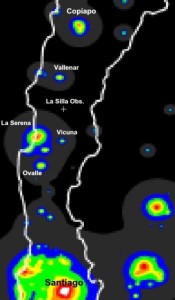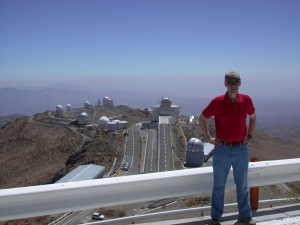Biography
 David Butler and his wife Gloria recently moved to Sierra Vista from North Carolina, where he was an active member of the Charlotte astronomy club. David studied Business at the University of North Carolina and later received his MS in Electrical Engineering from North Carolina State University. He spent nearly two decades in research and development in the emerging home automation industry, with an emphasis in energy management systems and advanced utility load control. During this time, he was a featured columnist for Electronic House magazine and later produced a nationally syndicated newspaper column on home technology. In recent years, Butler helped develop a breakthrough diagnostic tool for air conditioning contractors and won a federal grant to develop a low-cost monitoring system for residential air conditioners, partnering with Oak Ridge National Labs. Currently, Butler designs HVAC systems for high performance homes though Energy Star providers nationwide and is in the early stages of planning a small eco-village near Sierra Vista as a demonstration of cost-effective energy and water conservation. Butler belongs to the American Society of Heating, Refrigerating and Air-Conditioning Engineers.
David Butler and his wife Gloria recently moved to Sierra Vista from North Carolina, where he was an active member of the Charlotte astronomy club. David studied Business at the University of North Carolina and later received his MS in Electrical Engineering from North Carolina State University. He spent nearly two decades in research and development in the emerging home automation industry, with an emphasis in energy management systems and advanced utility load control. During this time, he was a featured columnist for Electronic House magazine and later produced a nationally syndicated newspaper column on home technology. In recent years, Butler helped develop a breakthrough diagnostic tool for air conditioning contractors and won a federal grant to develop a low-cost monitoring system for residential air conditioners, partnering with Oak Ridge National Labs. Currently, Butler designs HVAC systems for high performance homes though Energy Star providers nationwide and is in the early stages of planning a small eco-village near Sierra Vista as a demonstration of cost-effective energy and water conservation. Butler belongs to the American Society of Heating, Refrigerating and Air-Conditioning Engineers.
Presentation
At the Friday, January 18, 2008 meeting of the Huachuca Astronomy Club, the guest speaker was club member David Butler. His presentation was entitled, The Quest for Darker Skies. David’s talk related more of the human side of astronomy, rather than the technical aspects of the craft. Because he came from the Southeastern U.S., Dave shared some southern jokes, such as, “You might be a redneck if you thought ‘aperture fever’ was something you got vaccinated against as a kid.” Being from the Southeast region, Dave’s biggest frustration was not being able to observe the deep sky adequately, due to the constant hazy skies and the horrendous light pollution. Dave presented graphics on the problem of global light pollution to make a point about how hard it is to get away from it. The graphics demonstrated how difficult it is to find any dark skies now, especially in any of the highly populated portions of the United States. He mentioned the Google Earth application, which now features a night-view layer that gives a clear, local roadmap-like context to the blight of light pollution.
Dave used to travel to the Blue Ridge Parkway while living on the East Coast trying to find dark skies, and ended up literally on the Road to Nowhere. Dave finally planned an extended road trip to some of the darker areas of the Southwest in his journey to find dark skies. The first night he ended up in Mississippi. Dave checked the Sky Clock along the way, and traveled on to Arkansas, but he was winging it. At one point Dave drove twenty-five miles on dirt roads, running low on gas, until he reached a filling station that was about to close. With a full tank of gas and new directions, he continued on to find an open area where he could do some dark-sky observing. He then continued his quest and drove to Oklahoma, then Texas. While in Oklahoma, a friendly rancher took him to a range in the middle of his ranch to find dark skies. The rancher dropped him off, warned him about the rattlesnakes, and told him that there should not be a problem as long as he stayed out of the bush.
The presentation then described the ultimate fulfillment of his quest- his trip to Northern Chile’s Coquimbo region, with a 5-inch Mak-Star (130mm Intes Mak + NexStar mount), configured especially for the trip. Some regions of the Atacama Desert are so dry that there has been no recorded rainfall in history! Chile is also known for having extremely stable air, so this region sits underneath one of the clearest atmospheres in the world.
Dave’s traveling companions were his wife Gloria, and a small group that included Mark Wagner and Ray Cash. Gloria speaks Spanish, and it turned out to be a valuable skill because few are English-speaking there, as opposed to our closer neighbors such as Mexico. Dave first described some of the major observatories in Chile. The European Southern Observatory (ESO) operates the Very Large Telescope (VLT), located on Cerro Paranal, 2600 meters (8,530 feet) above the Atacama Desert. The VLT is the world’s most advanced optical instrument, consisting of four Unit Telescopes with main mirrors of 8.2 meters in diameter and four movable 1.8-meter diameter Auxiliary Telescopes. The telescopes can work together, in groups of two or three, to form a giant interferometer. The ESO also has plans for a 100-meter optical telescope, the Overwhelmingly Large Telescope (OWL), though this design may get scaled down. Although Dave’s group did not get to visit Paranal due to the distance involved, they did visit the ESO facility at La Silla, located 160 kilometers (99 miles) northeast of La Serena at the southern edge of the Atacama.
David spent the first part of the two-week excursion in La Serena, a four hour drive from his arrival point in Santiago, and then on to Vicua in the Elqui Valley east of La Serena. While in Vicua, he visited the Cerro Tololo Inter-American Observatory (CTIO) and the Southern Astrophysical Research Telescope (SOAR). CTIO is located about 45 minutes southwest of Vicuña, atop Cerro Tololo at 2200 meters (7,216 feet) elevation. The Blanco 4-meter telescope, commissioned in 1974, is a near-twin of the Mayall 4-meter telescope on Kitt Peak. The SOAR facility, located on nearby Cerro Pachón at 2738 meters (8,983 feet) above sea level, features a 4.2-meter optical and near-IR telescope. David was able to arrange a visit to SOAR, which had not yet been commissioned, because of its affiliation with his alma mater, the University of North Carolina, and his prior acquaintance with Dr. Wayne Christiansen.
The Chileans are serious about their astronomy. They recognize the precious resource they have with their dark skies; an idea which more Arizonans should support. There are several municipal observatories available for touring. One of these is the Mamalluca (pronounced “mama-yook”) Municipal Observatory located nine kilometers (five and a half miles) northeast of Vicuña. Mamalluca is an amateur-friendly facility. Collowara (pronounced “coyo-wara”) Observatory in Andocollo is another municipal observatory, owned by the government, and open to the public with a 16-inch Meade Dob and a 12-inch Meade SCT. Collowara means Starland in the Aymara language. David noted that the Elqui Valley region has many attractions, including good fresh food, wine, and the liquor “pisco,” made from grapes, which is the Chilean national drink.
One of the highlights of the trip was their stay at an astronomy-themed inn called La Frontera. This place offers astronomy pads with power. Here they ran into famous astrophotographer Loke Tan, who was also taking advantage of the location’s fantastic clear and dark skies. Although none of the deep-sky observers went all the way to Chile just to see Jupiter, they were all impressed with the view of the giant planet. David characterized the image as picture-postcard perfect.
David said it took a long time to plan for this dream trip. He said the time spent planning the trip was greater than the duration of the trip itself. He proposed the trip through a Yahoo discussion group on the Internet. The Internet site is now a resource for others planning astro-trekking trips to Chile. Since it is a discussion group, you must make a request to join the group, but all with any interest are welcome to join.
If you ever want to visit Chile, March is a good time to go. The high season in that part of the southern hemisphere runs from December through February. March in the northern hemisphere would be equivalent to September down there -the end of summer. So, the time is right. As for the distance, no place is too far to go for astronomers with a passion for dark skies and the celestial majesty they reveal.
Additional Information
Official Chile Trip web site. Discussion group related to astro-treking in Chile Including an extensive collection of astronomy and general travel links related to Chile.
Related webpages
Mark Wagner’s travelogue from 2005 Chile trip.
Ray Cash’s travelogue of 2005 Chile trip.
Ray Cash’s observing notes from 2005 Chile trip.


